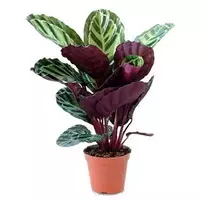Arrowroot

Maranta is an attractive plant that has a rather bright, varied color - its oblong leaflets with contrasting stripes are immediately striking. However, like any beauty, the maranta has a rather capricious character. A distinctive property of the maranta is that when creating conditions that are comfortable for the plant, the leaf plates are placed almost horizontally, but with a lack of moisture or light, they fold up. For this feature, maranta is often called "praying grass. "
There is undoubtedly something to brag about from an aesthetic point of view, but few people know that this is also a rather valuable plant for cooking. The fact is that in maranta rhizomes are distinguished by the presence of spindle-shaped tuberous thickenings that can be used for food.
Maranta tubers contain about twenty-five percent starch, making the plant a valuable food raw material. These tubers are used in cooked form or make special flour from them, which is called arrowroot. This flour is actively used in the preparation of bakery products, as well as in the manufacture of other nutritious dishes.
Types of maranta
In general, Maranta arundinacea is a small shrub of the Maranta family, the birthplace of which is considered the rain forests of South America. In natural conditions, many types of maranta can reach a height of up to a meter. In cultural conditions, it is considered an ornamental indoor plant, which is popular among flora lovers.
This family is unusually rich and diverse, and it consists of more than 100 species of maranta. The most common is the white-necked maranta, but no less popular varieties are also known, including kerchoveana, characterized by large brown spots on both sides of the central vein, massangeana, whose grayish-green foliage has silver veins.
In addition, several more types of maranta will stand out, which are common in our country. It is a tricolor maranta with yellow-green central markings and red veins, and a bricolor maranta that can be found significantly less frequently.
Maranta benefits
The benefits of maranta from a gastronomic point of view are due to the highly nutritious compositions of its tubers, which are rich in starch. On the other hand, the healing property of the maranta is also important to help improve sleep in the presence of such problems - it is enough to put a living plant next to the sleeping place. And there is also an opinion that the Maranta is capable of absorbing the energy of aggression, which is relevant for people prone to quarrels.
marants 65 kKal
Energy value of maranta (Ratio of proteins, fats, carbohydrates - ju):
Proteins: 4.24 g (~ 17 kCal)
Fats: 0.2 g (~ 2 kCal)
Carbohydrates: 12.09 (~ 48 kCal)
Energy ratio (bj | y): 26% | 3% | 74%
 Español
Español Français
Français Português
Português Русский
Русский 简体中文
简体中文 繁體中文
繁體中文 日本語
日本語 한국어
한국어 العربية
العربية Türkçe
Türkçe Қазақ
Қазақ Deutsch
Deutsch Italiano
Italiano Українська
Українська
